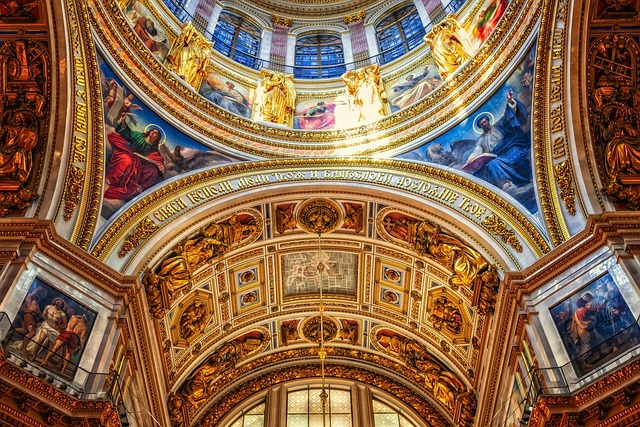The Orthodox cross, also known as the Russian cross or Byzantine cross, differs from other Christian crosses due to its unique design and symbolism.
Table of Contents
The Symbolism Behind the Orthodox Cross Design
Have you ever wondered why the Orthodox cross looks different from the crosses you see in other Christian denominations? Well, the answer lies in the rich symbolism behind its unique design. The Orthodox cross is not just a religious symbol; it is a visual representation of the core beliefs and values of the Orthodox Christian faith.
At first glance, the Orthodox cross may appear similar to the Latin cross, which is commonly associated with Western Christianity. However, upon closer inspection, you will notice some distinct differences. The most noticeable variation is the presence of three horizontal bars instead of one. This additional bar, known as the slanted footrest, holds great significance in Orthodox theology.
The top bar of the Orthodox cross represents the sign that was placed above Jesus’ head during his crucifixion. It reads “INRI,” which stands for “Jesus of Nazareth, King of the Jews.” This inscription serves as a reminder of Jesus’ earthly kingship and his ultimate sacrifice for humanity. It also symbolizes the triumph of Christ over sin and death.
The middle bar of the Orthodox cross represents the wooden beam on which Jesus was nailed. It is positioned slightly lower than the top bar, signifying the division between heaven and earth. This placement emphasizes the belief that through his crucifixion, Jesus bridged the gap between God and humanity, offering salvation to all who believe in him.
The slanted footrest, the distinctive feature of the Orthodox cross, holds a profound meaning. It represents the footrest that was used to support the weight of Jesus’ body during his crucifixion. This footrest serves as a reminder of Jesus’ humanity and his willingness to endure unimaginable suffering for the sake of humanity’s redemption. It also symbolizes the invitation for believers to take up their own crosses and follow Christ’s example of self-sacrifice and love.
Another significant aspect of the Orthodox cross is the absence of the corpus, the body of Jesus. Unlike the crucifixes commonly seen in Western Christianity, the Orthodox cross does not depict Jesus’ physical form. This intentional omission serves as a reminder that Christ is no longer on the cross but has risen from the dead. It emphasizes the Orthodox belief in the resurrection and the hope of eternal life.
The symbolism behind the design of the Orthodox cross goes beyond its physical appearance. It encapsulates the core teachings of the Orthodox Christian faith, emphasizing the kingship of Christ, his sacrifice for humanity, and the call for believers to follow in his footsteps. It serves as a visual reminder of the central message of Christianity – the triumph of love and redemption over sin and death.
Next time you come across an Orthodox cross, take a moment to appreciate its unique design and the profound symbolism it carries. Let it serve as a reminder of the rich heritage and deep spirituality of the Orthodox Christian tradition. And may it inspire you to reflect on the ultimate sacrifice of Jesus and the invitation to live a life of selflessness and love.
Historical Evolution of the Orthodox Cross

The Orthodox Cross is a symbol that holds great significance in the Eastern Orthodox Church. It is a distinctive representation of the crucifixion of Jesus Christ and is often seen adorning churches, icons, and religious artifacts. While the basic shape of the cross remains the same, it is interesting to note that there are variations in its design among different Orthodox communities. In this article, we will explore the historical evolution of the Orthodox Cross and understand why it differs across regions.
To understand the variations in the Orthodox Cross, we must delve into its historical roots. The cross, as a symbol of Christianity, has been used since the early days of the faith. However, it was during the Byzantine Empire that the Orthodox Cross began to take on its unique form. The Byzantines were known for their intricate artwork and attention to detail, and this was reflected in their depiction of the cross.
One of the most recognizable variations of the Orthodox Cross is the Russian Orthodox Cross. This cross features three horizontal bars, with the top bar representing the sign that was placed above Jesus’ head on the cross. This distinctive design is believed to have originated in the 17th century and has since become synonymous with Russian Orthodoxy.
In contrast, the Greek Orthodox Cross is characterized by a slanted bar at the bottom. This slant is said to represent the footrest on which Jesus’ feet were nailed during his crucifixion. The Greek Cross is often seen as a symbol of humility and is widely used in Greek Orthodox churches and religious art.
Moving further east, we come across the Ethiopian Orthodox Cross. This cross is unique in that it features a circular shape at the top, representing the crown of thorns worn by Jesus during his crucifixion. The Ethiopian Cross is intricately carved and often adorned with precious stones, reflecting the rich cultural heritage of the Ethiopian Orthodox Church.
The variations in the Orthodox Cross can be attributed to the diverse cultural and historical influences that have shaped different Orthodox communities. Over the centuries, as Christianity spread across different regions, local customs and traditions began to merge with the core teachings of the faith. This fusion of cultures gave rise to unique interpretations of the cross.
It is important to note that while the design of the Orthodox Cross may differ, its underlying symbolism remains the same. The cross is a powerful reminder of Jesus’ sacrifice and serves as a symbol of hope and redemption for Orthodox Christians worldwide. Regardless of the specific design, the Orthodox Cross serves as a unifying symbol for believers, connecting them to their shared faith and heritage.
In conclusion, the Orthodox Cross has evolved over time, reflecting the rich history and cultural diversity of Orthodox communities. From the Russian Orthodox Cross to the Greek Orthodox Cross and the Ethiopian Orthodox Cross, each variation carries its own unique symbolism and significance. While the differences in design may be visually striking, they ultimately serve to deepen the spiritual connection between believers and their faith. The Orthodox Cross stands as a testament to the enduring power of Christianity and its ability to adapt and thrive in different cultural contexts.
Cultural Variations in Orthodox Crosses
Have you ever noticed that Orthodox crosses can look quite different from one another? It’s fascinating to see the cultural variations in these crosses, which are an important symbol in the Orthodox Christian faith. Let’s take a closer look at why Orthodox crosses differ and what these variations mean.
One of the main reasons for the differences in Orthodox crosses is the rich cultural diversity within the Orthodox Christian community. Orthodox Christianity is practiced in various countries around the world, including Greece, Russia, Ethiopia, and many others. Each of these cultures has its own unique traditions and artistic styles, which are reflected in the design of their crosses.
For example, the Greek Orthodox cross, also known as the Byzantine cross, is characterized by its intricate and ornate design. It typically features a slanted crossbeam, representing the inscription that was placed above Jesus’ head on the cross. This style of cross is often adorned with decorative patterns and symbols, such as the Greek letters alpha and omega, which symbolize the beginning and the end.
On the other hand, the Russian Orthodox cross has a simpler and more straightforward design. It usually consists of a straight vertical beam and a shorter horizontal beam near the top. This style of cross is often associated with the Russian Orthodox Church, which has a long history and a strong influence on Russian culture. The simplicity of the Russian Orthodox cross reflects the emphasis on humility and austerity in the Russian Orthodox tradition.
In Ethiopia, the Ethiopian Orthodox cross is a distinctive and elaborate design. It is often made of wood or metal and features intricate carvings and engravings. The Ethiopian Orthodox Church has a unique blend of Christian and traditional Ethiopian beliefs, and this is reflected in the design of their crosses. The Ethiopian Orthodox cross often incorporates traditional Ethiopian symbols and motifs, such as the Ethiopian cross, which is a symbol of protection and blessing.
These cultural variations in Orthodox crosses not only reflect the artistic styles of different cultures but also carry deep spiritual and symbolic meanings. The cross is a central symbol in Christianity, representing the crucifixion and resurrection of Jesus Christ. However, each culture interprets and expresses this symbolism in its own way.
For example, the slanted crossbeam in the Greek Orthodox cross is said to represent the balance between the good thief and the bad thief who were crucified alongside Jesus. The Russian Orthodox cross, with its simple and straight design, is believed to symbolize the straight path to salvation. The Ethiopian Orthodox cross, with its intricate carvings and traditional symbols, represents the rich cultural heritage and spiritual beliefs of the Ethiopian Orthodox Church.
In conclusion, the cultural variations in Orthodox crosses are a testament to the diversity and richness of the Orthodox Christian faith. These crosses not only reflect the artistic styles of different cultures but also carry deep spiritual and symbolic meanings. Whether it’s the ornate Greek Orthodox cross, the simple Russian Orthodox cross, or the elaborate Ethiopian Orthodox cross, each design tells a unique story and represents a unique expression of faith. So next time you come across an Orthodox cross, take a moment to appreciate the cultural variations and the profound symbolism behind it.
The Significance of Orthodox Crosses in Religious Practices
Have you ever noticed that Orthodox Christians wear crosses that look different from the ones you typically see? If you’ve ever been curious about the significance of these crosses in religious practices, you’re in the right place. In this article, we’ll explore why Orthodox crosses are different and what they represent.
Orthodox crosses, also known as Eastern Orthodox crosses, have a distinct design that sets them apart from other Christian crosses. The most noticeable difference is the presence of three horizontal bars instead of one. The top bar represents the sign that was placed above Jesus’ head during his crucifixion, which read “Jesus of Nazareth, King of the Jews.” The middle bar represents the crossbeam on which Jesus was nailed, while the bottom bar represents the footrest.
This unique design holds deep symbolism for Orthodox Christians. It serves as a reminder of Jesus’ sacrifice and the salvation he brought to humanity through his crucifixion. The three bars also represent the Holy Trinity, which is central to Orthodox theology. The Father, Son, and Holy Spirit are believed to be three distinct persons who are united in one divine essence. The three bars on the cross serve as a visual representation of this fundamental belief.
Another distinctive feature of Orthodox crosses is the slanted footrest. This slant is said to symbolize the conversation between Jesus and the thief who was crucified alongside him. According to the Gospel of Luke, one of the thieves acknowledged Jesus as the Son of God and asked him to remember him when he entered his kingdom. Jesus responded by promising the thief that he would be with him in paradise. The slanted footrest on the Orthodox cross is a visual representation of this conversation and serves as a reminder of God’s mercy and forgiveness.
Orthodox crosses also often feature intricate designs and details. These designs can vary depending on the region and cultural influences. Some crosses may incorporate traditional motifs or symbols that hold special meaning within a particular Orthodox community. These intricate designs not only add beauty to the cross but also serve as a way for individuals to express their faith and cultural identity.
In addition to their religious significance, Orthodox crosses are also worn as a form of personal devotion and protection. Many Orthodox Christians believe that wearing a cross can serve as a physical reminder of their faith and a source of spiritual strength. It is common for Orthodox believers to wear a cross necklace or carry a small cross with them as a way to stay connected to their religious beliefs throughout the day.
So, the next time you see an Orthodox cross, take a moment to appreciate its unique design and the deep symbolism it holds. These crosses are not just pieces of jewelry; they are powerful symbols of faith, reminding believers of Jesus’ sacrifice, the Holy Trinity, and God’s mercy. Whether you are Orthodox or not, understanding the significance of these crosses can deepen your appreciation for the rich traditions and beliefs of Orthodox Christianity.
Conclusion
The Orthodox cross differs from other Christian crosses due to its unique design and symbolism. It features three horizontal bars, with the top bar representing the sign that was placed above Jesus’ head during his crucifixion, which read “Jesus of Nazareth, King of the Jews.” The bottom slanting bar represents the footrest, while the longer vertical bar represents the cross itself. This distinctive design is deeply rooted in the traditions and beliefs of the Eastern Orthodox Church, reflecting their interpretation of the crucifixion and the significance of Jesus’ sacrifice.
For licensing reasons, we must provide the following notice: This content was created in part with the help of an AI.


